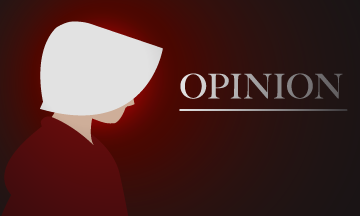
Content warning: This story includes details of sexual assault that might be upsetting to some readers.
Reading is my unduly treasured, self-employed avocation. So, once a trailer for “The Handmaid’s Tale” series appeared, I naturally reached first for the book, written by Margaret Atwood in 1985. While I was sucked into the fictional world of Gilead within its pages, it was not because I found Atwood’s writing excellent.
It was my imagination together with my building anxiety that carried me through the book and straight into the series.
But it was long before Gilead and all its characters came to life on a screen, that I realized how little I actually need imagination and how much I rely on real-life examples to build a mental stage for each scene.
With the dystopian plot being nearly lifelike and the series incorporating various social issues we are facing today, I find “The Handmaid’s Tale” to be one of the most important and relevant shows out there.
In our current world, where women do not only still fight for equality, but also live on the brink of oppression of their reproductive rights, the series is nearly too relatable and reflective of today’s America.
The timing could not have been more perfect, with the first season streaming in 2017, right after President Donald Trump’s induction and the second season arriving amid the #MeToo movement in 2018. The first three episodes of its third season aired in June, as a number of abortion bans started to spread through nine U.S. states.
“The Handmaid’s Tale” tells a story of the oppressive Republic of Gilead—formerly known as the United States. Gilead’s government returned to its deepest core values and the most literal interpretation of the Bible to improve the declining fertility rate. Women of Gilead are not allowed to work, write, read or be educated. Fertile women are enslaved as handmaids and bare children for commanders by whom they are raped in monthly ceremonies.
The story is narrated by a smart and determined handmaid named June Osbourne, played by Elisabeth Moss. In the Republic of Gilead, her name is changed to Offred, based on the name of her new master.
To put it simply, Gilead is the worst possible nightmare a woman could wake up into.
Children, born or yet unborn, are the most precious and protected treasure in Gilead, no matter how they were conceived and without biological mothers having any say in regards to the pregnancy or their bodies. Does that sound familiar?
If handmaids were mothers before the creation of the new totalitarian regime, their children were taken away from them, renamed and adopted by commanders and their wives, who themselves were unable to conceive. Does any of this ring any bells?
White supremacy rules the elite society in Gilead and minorities appear in the series only as servants. Nevertheless, the white leadership does not seem to mind raising biracial children born to their handmaids of color. Does it drive the point home?
While the story takes the development a step further from our current state, it raises the question that the main character often asks herself: how did we let this happen?
“The Handmaid’s Tale” is a provocative, sarcastic, frightening and mind-blowing series. It is beyond one’s wildest nightmares, yet so realistic. It’s scary, yet so empowering. In the current political climate, it is hitting many sensitive spots, but despite that, or maybe even because of that, it is definitely worth watching.
By watching, I won’t stop Trump and his followers from overturning Roe v. Wade, and I won’t solve any other social issues for that matter, but I feel motivated enough to voice my opinion, partake in a conversation and to further my education about it.
If nothing else, it’s a start.



Be the first to comment